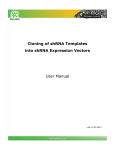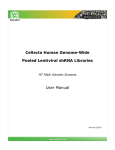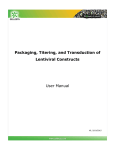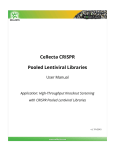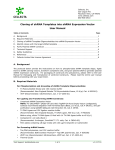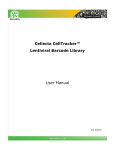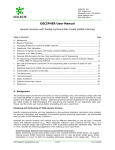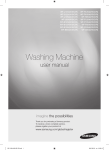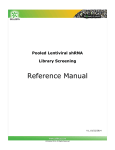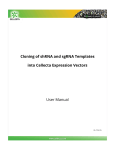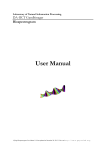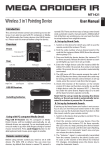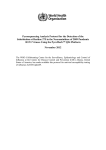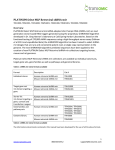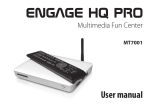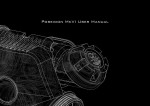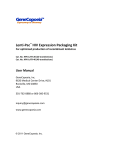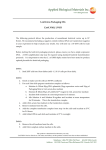Download User Manual
Transcript
Cellecta DECIPHER™ Pooled Lentiviral shRNA Libraries HT RNAi Genetic Screens User Manual V9a, 9/15/2015 Cellecta DECIPHER shRNA Libraries www.cellecta.com User Manual Contents A. Background ....................................................................................................................................... 3 B. DECIPHER Project Required Materials .............................................................................................. 4 B.1. Included Materials ............................................................................................................................. 4 B.2. Materials Available Separately from Cellecta .................................................................................... 4 B.3. Materials Needed from Other Vendors ............................................................................................. 5 B.4. Related Services from Cellecta .......................................................................................................... 7 C. Packaging Protocol for Pooled Lentiviral shRNA Libraries ................................................................ 7 C.1. Day 0 – Plate Cells .............................................................................................................................. 7 C.2. Day 1 – Transfection (Ten 15-cm plates*) ......................................................................................... 8 C.3. Day 2 – DNAse I Treatment................................................................................................................ 8 C.4. Day 3 – Collect Lentiviral Supernatant............................................................................................... 9 C.5. Concentrating Virus (Optional) .......................................................................................................... 9 D. Transduction Protocols, Lentiviral Titer Estimation, and Screening Protocols ............................... 10 E. Genomic DNA Extraction for Barcode Amplification and HT Sequencing ............................................. 10 F. Amplification of shRNA-specific Barcodes from Genomic DNA...................................................... 11 F.1. First Round of PCR ............................................................................................................................ 12 F.2. Second Round of PCR ....................................................................................................................... 13 G. HT Sequencing of Pooled shRNA-specific Barcodes on Illumina’s GAIIx or HiSeq .......................... 15 H. Barcode Enumeration (Conversion of raw sequencing data to number of reads for each barcode) .................................................................................................................................................. 15 I. Troubleshooting: Difficulties with Probe Preparation and HT Sequencing .................................... 16 I.1. No PCR Product ......................................................................................................................... 16 I.2. No barcodes present in HT Sequencing results ........................................................................ 16 J. Technical Support ........................................................................................................................... 17 K. Safety Guidelines ............................................................................................................................ 18 L. References ...................................................................................................................................... 18 M. Appendix ............................................................................................................................................... 19 M.1. Lentiviral shRNA Expression Vector Maps* .............................................................................. 19 M.2. HT Sequencing Primers ............................................................................................................. 19 M.2.1. HTS4 Cassette .......................................................................................................................... 19 M.2.2. HTS3 Cassette .......................................................................................................................... 20 [email protected] 2 of 25 v9a, 9/15/2015 Cellecta DECIPHER shRNA Libraries www.cellecta.com User Manual M.3. Common Library Vector Features ............................................................................................. 21 M.4. DECIPHER Library HT Sequencing Q.C. Data ............................................................................. 22 M.5. DECIPHER Library Individual Clone Sequencing Q.C. Data........................................................ 22 M.6. DECIPHER Project Resources .................................................................................................... 23 M.6.1. Barcode Analyzer and Deconvoluter ....................................................................................... 23 M.6.2. List of Functionally Validated shRNA ....................................................................................... 23 M.6.3. RNAi Generator Tool................................................................................................................ 23 N. Terms and Conditions ..................................................................................................................... 24 A. Background DECIPHER libraries are barcoded lentiviral shRNA libraries optimized for RNAi Genetic Screens in a pooled format. They are made to cover most of the human and mouse gene set, but are not completely genome-wide. DECIPHER libraries have A high percentage of functionally validated sequences 5 to 6 shRNAs per gene results in at least 70% knockdown efficiency for approximately 65% of the target genes represented (depending on the cell type) Equally represented shRNA constructs with differences in concentrations not exceeding one order of magnitude Typically, about 80-90% of the population of shRNA constructs present within a 10-fold range The barcodes in the DECIPHER libraries are composed of an 18-nt sequence and facilitate HT sequencing data analysis and identification of functional shRNAs using the Illumina HT Sequencing platform. Barcodes are identified and converted to lists of genes/shRNA with enumerated barcode data, and amplification of the specific shRNA hairpins for detection is not required. The protocols below provide the instructions on how to package the DECIPHER pooled lentiviral shRNA libraries and how to isolate and amplify the barcodes after your RNAi screen. Please read the entire user manual before proceeding with your experiment. For a description of the theories behind using pooled shRNA lentiviral libraries, information on viral transduction, titering, or for examples of positive and negative screens using pooled lentiviral libraries, please read the Pooled Lentiviral shRNA Library Screening Reference Manual. The protocols and methods apply specifically to DECIPHER Modules 1-3. To ensure you have the latest version of this user manual, please visit http://www.cellecta.com/resources/protocols/. [email protected] 3 of 25 v9a, 9/15/2015 Cellecta DECIPHER shRNA Libraries www.cellecta.com User Manual IMPORTANT: The barcode sequences in Human Modules 2 and 3 have significant overlap, therefore these modules cannot be combined in any step of the procedure including HT Sequencing. Library Vector Target Genes # mRNA # shRNA Catalog # Human Module 1 pRSI12 Signaling Pathways 5,043 27,500 DHPAC-M1-P Human Module 2 pRSI12 Disease-Associated 5,412 27,500 DHDAC-M2-P Human Module 3 pRSI12 Cell Surface, Extracellular, DNA Binding 4,922 27,500 DHCSC-M3-P Mouse Module 1 pRSI12 Signaling Pathways 4,625 27,500 DMPAC-M1V2-P Mouse Module 2 pRSI12 Disease-Associated 4,520 27,500 DMDAC-M2V2-P NOTE: The module names in DECIPHER are used solely for convenience to describe the major groups of genes targeted in the module. Many genes targeted in a module do not fall within the description, all modules target a variety of genes throughout the genome, and not all genes generally considered to fall under a specific description will be found in the module with the specific gene description. Please refer to the gene lists and complete gene annotations (available on the DECIPHER website at http://www.decipherproject.net/support/#gene-lists) associated with each module for detailed information regarding which genes are present in each specific module. Also, each module targets an orthogonal set of mRNA transcripts so there is no overlap in the targets between modules. B. DECIPHER Project Required Materials B.1. Included Materials 120 μg of each plasmid library ordered, in the pRSI12-U6-(sh)-HTS4-UbiC-TagRFP-2A-Puro vector; enough to generate lentivirus for approximately 50-100 screens (depending on cell type) 10 μg empty library vector, as a packaging and transduction control; or, after linearization by BbsI/BpiI restriction digest, for cloning individual constructs used to validate hits from your screen User Manual and Product Analysis Certificates (http://www.cellecta.com/resources/productmanuals-and-certificates/) List of shRNA and barcode sequences (http://www.decipherproject.net/support/) HT Sequencing QC data of plasmid libraries (http://www.decipherproject.net/support/) The vector map, sequence, feature map, and restriction map can be downloaded from the DECIPHER Project website at http://www.decipherproject.net/support/. B.2. Materials Available Separately from Cellecta Lentiviral packaging mix (Cat. #CPCP-K2A). (Libraries can be packaged into lentiviral particles with nearly any 2nd or 3rd generation HIV-based lentiviral packaging mix. Cellecta’s lentiviral packaging mix contains two plasmids: psPAX2 and pMD2.G, pre-mixed in an appropriate ratio.) Positive control (targeting) lentiviral shRNA constructs (Custom or premade) Negative control (non-targeting) lentiviral shRNA constructs (Custom or premade) [email protected] 4 of 25 v9a, 9/15/2015 Cellecta DECIPHER shRNA Libraries www.cellecta.com User Manual Linearized shRNA expression vector, for cloning individual constructs used to validate hits from your screen LentiFuge, lentiviral concentration reagent The following custom services are available from Cellecta at additional cost. For more information, visit www.cellecta.com, email us at [email protected], or call +1-650-938-3910. Additional Products and Services Ready-to-Use Packaging Plasmid Mix (250 μg) Catalog # CPCP-K2A LentiFuge™ Viral Concentration Reagent (1000X), for 1 L supernatant LFVC1 DECIPHER Module Packaging (2 × 10^8 TU or 1 × 10^9 TU per module) CLVP-2E8, CLVP-LGLIB HT Sequencing of DECIPHER Library experimental samples (frozen cells, DNA, or xenograft) CANA-SQ, CANA-SQD, CANA-SQT Pre-made or Custom Lentiviral shRNA Constructs (Plasmid or Packaged) Cloning DECIPHER Module into Custom shRNA library vector Many DCLN-M-P B.3. Materials Needed from Other Vendors 293T/17 Cell Line (ATCC, Cat.# CRL-11268™) Dulbecco's Modified Eagle Medium (D-MEM) (1X) (Mediatech CellGro, Cat.# 15-013-CV) NOTE: ADD FRESH GLUTAMINE (1X) at the time a sealed bottle of D-MEM is opened, even if the label indicates glutamine has already been added. Glutamine in solution at +4°C has a half-life of 1–2 months, so glutamine(+) D-MEM purchased “off-the-shelf” from a supplier is to be regarded as glutamine(-). In our experience, the addition of glutamine increases titer approximately 2-fold. If DMEM comes supplemented with stable L-Alanyl-L-Glutamine dipeptide, addition of fresh glutamine is not necessary. Glutamine (L-Alanyl-L-Glutamine, Dipeptide L-glutamine) (Mediatech, Cat.# 25-015-CI) HEPES MgCl2 Fetal Bovine Serum (recommended: Mediatech, Cat.# MT 35-010-CV) Puromycin D-PBS (Mediatech, Cat. # 21-031-CV) Trypsin-EDTA (Mediatech, Cat. # 15-040-CV) Polybrene® (hexadimethrine bromide) (Sigma-Aldrich, Cat.# 107689) 500 ml, 0.2 μm filter units (Fisher Scientific Cat.# 09-741-05 or Thermo Scientific Cat.# 5690020) Tissue Culture Plates and Related Tissue Culture Supplies Lipofectamine™ Reagent (Life Technologies, Cat.# 18324-020) [email protected] 5 of 25 v9a, 9/15/2015 Cellecta DECIPHER shRNA Libraries www.cellecta.com User Manual Plus™ Reagent (Life Technologies, Cat.# 11514-015) 15-ml BD FALCON screw-cap centrifuge tubes (12,000 RCF rated, PP, P:CHCl3-resistant, BD Biosciences, Cat.# 352196) Buffer P1 (50mM Tris-HCl pH 8.0, 10mM EDTA) (QIAGEN, Cat.# 19051) RNase A (QIAGEN, Cat.# 19101) Sonicator for Genomic DNA Shearing Phenol:Chloroform pH 8.0 (Sigma-Aldrich, Cat.# P3803) DNase I, RNase-free (Epicentre, Cat. D9905K) Titanium Taq DNA polymerase with PCR buffer (Clontech-Takara, Cat.# 639242) dNTP Mix (10 mM each) (GE Healthcare, Cat. # 28-4065-52) QIAquick PCR purification kit (QIAGEN, Cat.# 28106) QIAquick Gel Extraction Kit (QIAGEN, Cat.# 28706) Primer for sequencing shRNA inserts in shRNA constructs (IDT)*: See Appendix M PCR primers for barcode amplification from genomic DNA (IDT)*: See Appendix M HT sequencing primers (IDT)*: See Appendix M [email protected] 6 of 25 v9a, 9/15/2015 Cellecta DECIPHER shRNA Libraries www.cellecta.com User Manual HT Sequencing Kits (Illumina): Platform Kit Type Illumina Cat.# Description Sequencing FC-104-5001 TruSeq SBS Kit v5 – GA (36-cycle) Cluster Generation GD-203-5001 TruSeq SR Cluster Kit v5 – CS – GA Sequencing FC-401-3002 TruSeq SBS Kit v3 – HS (50 cycle) Cluster Generation GD-401-3001 TruSeq SR Cluster Kit v3-cbot-HS Sequencing FC-404-2005 NextSeq 500 v2 Kit GAIIx HiSeq* NextSeq 500 * See Illumina website for information on HiSeq 2500 rapid run kits. NOTE: We currently do not support HT sequencing of samples on the Illumina MiSeq. B.4. Related Services from Cellecta Custom Pooled shRNA Library Construction RNAi Functional Genetic Screens with Pooled shRNA Libraries, Cat.# CRGS-X HT Barcode Sequencing of Cell Pellets, DNA, or Xenografts from RNAi Screen (with Cellecta Library) Pre-made and Custom shRNA and CRISPR Constructs Linearized shRNA Expression Vectors C. Packaging Libraries Protocol for Pooled Lentiviral shRNA The following protocol describes the generation of a packaged DECIPHER pooled lentiviral 27K shRNA library (27K shRNA complexity) using Invitrogen’s Lipofectamine™ and Plus™ Reagent. Other transfection reagents may be used, but the protocol should be adjusted to fit the manufacturer’s protocol. The yield of recombinant lentiviral particles typically produced under these optimized conditions is 1-10 × 106 TU/ml. In this protocol, using ten (10) 15-cm plates, at least 3 × 108 TU of total lentiviral particles can be made and then concentrated to up to 100-fold using several described methods. We do not recommend scaling down the lentiviral packaging protocol due to risk of compromising the representation of the shRNA library. 1. Start growing 293T cells in D-MEM medium plus glutamine, supplemented with 10% FBS without antibiotics, 2 to 3 days prior to transfection. C.1. Day 0 – Plate Cells 2. Twenty four (24) hours prior to transfection, plate 12.5 × 10 6 293T cells in each of ten (10) 15-cm plates (or 150 cm2 flasks). Use 30 ml of media per plate. Disperse the cells and ensure even distribution. At the moment of transfection, the cells should have reached ~80% confluency. Increase or decrease the number of 293T cells seeded if optimal confluency is not achieved in 24 hours. Incubate at 37°C in a CO2 incubator for 24 hours. [email protected] 7 of 25 v9a, 9/15/2015 Cellecta DECIPHER shRNA Libraries www.cellecta.com User Manual C.2. Day 1 – Transfection (Ten 15-cm plates*) 3. In sterile 50-ml polypropylene tube, mix the Ready-to-use Packaging plasmid mix with the plasmid DECIPHER library and add the plasmid mixture to D-MEM medium without serum or antibiotics. Add the Plus Reagent, mix, and incubate at room temperature for 15 min. See the table below for the volumes to use. 10X 15-cm plates 600 μl 60 μl 12,000 μl Component Ready-to-use Packaging Plasmid Mix (0.5 μg/μl) * Plasmid shRNA Library (1 μg/μl) * D-MEM, no FBS, no antibiotics 600 μl Plus Reagent 13,260 μl Total volume * IMPORTANT: DO NOT use less than ten 15-cm plates to package a batch of DECIPHER or 27K library. A smaller amount may cause shRNA insert representation to be adversely affected. 4. Add Lipofectamine Reagent to the D-MEM medium without serum or antibiotics in order to make a convenient master mix according to the table below. Mix gently. 10X plates 12,000 μl 900 μl 12,900 μl Component D-MEM, no FBS, no antibiotics Lipofectamine Total volume 5. Add the diluted Lipofectamine Reagent (from step 4) to the DNA / Plus Reagent complex (from step 3), mix gently by flicking the tube or vortexing and incubate at room temperature for 15 min. 6. Add 2.5 ml of the DNA / Plus Reagent / Lipofectamine Reagent complex (from step 5) to each 15cm plate from step 2, and mix complexes with medium by gentle rotation. Take care not to dislodge cells from the plate. Incubate at 37°C in the CO2 incubator for 24 hours. C.3. Day 2 – DNAse I Treatment 7. At 24 hours post-transfection, replace the medium containing complexes with fresh 30 ml D-MEM medium supplemented with 10% FBS, DNase I (1 U/ml), MgCl 2 (5 mM), 20mM HEPES pH7.4. Continue incubation in the CO2 incubator at 37°C overnight. Overnight DNase I treatment before harvesting virus does not negatively affect lentiviral titer or infectivity and helps prevent undesirable carryover of plasmid library into the virus prep. NOTE: Failure to change the media the day after transfection results in large carryover of plasmid (free and/or Lipofectamine-bound) in your lentiviral prep. This may cause problems with most downstream molecular biology applications, especially whenever there is a PCR step involved. [email protected] 8 of 25 v9a, 9/15/2015 Cellecta DECIPHER shRNA Libraries www.cellecta.com User Manual C.4. Day 3 – Collect Lentiviral Supernatant 8. At 48 hours post-transfection, collect all 30 ml of the virus-containing medium from each plate and filter the supernatant (300 ml) through a Nalgene 0.2 μm PES filter (a low protein binding filter) to remove debris and floating packaging cells. Failure to filter supernatant could result in carry-over of cells into your lentiviral prep. NOTE: Usually, the peak of virus production is achieved at 48 hours post-transfection. Supernatant can also be collected again at 72 hours post-transfection—replace the collected 48-hour supernatant with 30 ml of fresh D-MEM medium supplemented with 10% FBS, 20mM HEPES pH7.4 and continue incubation in the CO2 incubator at 37°C for 24 hours. CAUTION: You are working with infectious lentiviral particles at this stage. Please follow the recommended guidelines for working with BSL-2 safety class materials (see Safety Guidelines). 9. Proceed to concentration step, or aliquot and store the non-concentrated supernatant at –80°C. Freezing and thawing usually results in ~20% loss of lentiviral titer with each cycle. Cellecta offers lentiviral packaging services. Please contact us at [email protected] or visit http://www.cellecta.com/products-and-services/lentiviral-packaging/ for more information. C.5. Concentrating Virus (Optional) Although concentrating virus is optional, it is recommended if (1) very high titer virus stock is needed to achieve desired MOI in hard-to-transduce target cells, (2) virus should be suspended in another media (besides DMEM/10%FBS) which is optimal for sensitive target cells, or (3) 18 hour posttransduction baseline control is used in your screen (to minimize problems with possible plasmid library carry-over). However, because of the additional manipulation of samples, there is the added risk of contamination and loss of virus. The following protocol was optimized to concentrate virus with high recovery. The protocol assumes that lentiviral supernatant was harvested 48 hours after transfection and filtered as in step 8 above. 1. Aliquot lentiviral supernatant in clear sterile centrifuge tubes. 2. Add LentiFuge to a final concentration of 5 μg/ml, and incubate for 1 hour at +4°C. 3. Centrifuge at 10,000 rpm for at least 1 hour at +4°C in a Beckman JA-14 (or JA-10) or equivalent rotor. Mark the tubes to identify the location where the pellet will be. At the end of centrifugation, you may or may not be able to see a pellet—assume it is at the location of the mark. 4. Immediately discard the supernatant by aspirating. 5. Place the tubes on ice, resuspend the (in)visible pellet in PBS/10%FBS (or PBS/1%BSA), make aliquots, and freeze at –80°C. Alternatively, you may concentrate virus by the any of the methods below. virus is superior (~80% recovery) using Cellecta’s protocol above. Ultracentrifugation at 50,000 g for 90 minutes at +4°C Sucrose cushion ultracentrifugation PEG precipitation, followed by centrifugation [email protected] 9 of 25 However, the yield of v9a, 9/15/2015 Cellecta DECIPHER shRNA Libraries www.cellecta.com User Manual D. Transduction Protocols, Lentiviral Titer Estimation, and Screening Protocols For complete protocols on transduction of target cells with pooled lentiviral shRNA libraries, titer estimation, and examples of screening protocols, please see the Pooled Lentiviral shRNA Library Screening Reference Manual. E. Genomic DNA Extraction for Barcode Amplification and HT Sequencing Identification of shRNA barcodes in the experimental samples requires amplification of the barcode portion of the integrated lentiviral constructs from sample genomic DNA. Subsequent high-throughput sequencing of barcodes by the Illumina GAIIx or HiSeq is done to quantify each barcode and generate digital expression data using Deconvolution software. We currently do not support HT sequencing of samples on the Illumina MiSeq. Due to the large amount of cells and resulting genomic DNA, the following protocol is recommended for isolating genomic DNA, rather than using a commercial column-based kit. Use of a commercial column-based kit may result in loss of genomic DNA and loss of representation of barcodes that survived the screening protocol. Cellecta now offers sample prep, HT sequencing, and analysis services. Please contact us at [email protected] or visit http://www.cellecta.com/products-services/cellecta-pooled-lentivirallibraries/next-gen-sequencing-and-analysis/ for more information. If you are starting with fewer than 1 million cells, we recommend using the Qiagen QIAamp DNA Micro Kit, according to the manufacturer’s instructions, instead of using the protocol here. NOTE: Use of disposable tubes is highly recommended in order to avoid contamination. 1. Suspend cell pellet in 5 ml QIAGEN buffer P1 (with RNaseA) in 15 ml POLYPROPYLENE (phenol/chloroform resistant), BD FALCON screw-cap centrifuge tube (12,000 RCF rated, BD Biosciences Cat. #352196). 2. Add 0.25 ml 10% SDS, mix and incubate 5 minutes at RT. 3. Using an ultrasonic homogenizer, sonicate to shear DNA into 10-100 kb sized fragments. To prevent cross-contamination, thoroughly wash the ultrasound head with running water and dry with clean paper towel between samples. 4. Add 10 ul of proteinase K, mix and incubate 15 minutes at RT. 5. Add 5 ml Phenol:Chloroform:Isoamyl Alcohol solution, vortex hard and spin down 60 min, +20°C at 8,000 rpm in JA-14 or equivalent rotor (Beckman). 6. You should have about 5 ml of clear upper phase. Transfer 4 ml of upper phase to new 15 ml DISPOSABLE screw cap tube (same as in Step 1). 7. Add 0.5 ml 3M Sodium Acetate, 4 ml isopropanol, mix well, and spin down 30 min, +20°C at 8,000 rpm in JA-14 or equivalent rotor. 8. In order to have a more visible pellet, compacted at the bottom of the tube, it is recommended to incubate overnight at RT before centrifugation. IMPORTANT: If starting material is less than 5 million cells, add carrier before centrifugation (linear polyacrylamide, 25 μg/ml final) and spin down for a longer time (60 min). [email protected] 10 of 25 v9a, 9/15/2015 Cellecta DECIPHER shRNA Libraries www.cellecta.com User Manual 9. Discard supernatant, add 10 ml 70% ethanol, spin down 5 min, +20°C at 8,000 rpm in JA-14 or equivalent rotor. 10. Discard supernatant and air-dry pellet. 11. Dissolve DNA pellet in appropriate volume of dH2O to a concentration of approximately 2 mg/ml. Expected yield is about 10 μg per 1 million cells. 12. Incubate 30 minutes at +80°C before spectrophotometer reading. F. Amplification Genomic DNA of shRNA-specific Barcodes from An adequate amount of DNA needs to be used in the first amplification to ensure full representation of the barcodes from all the cells isolated from each experimental sample. For negative screens where DNA was isolated in the previous step from 25 million or more cells, the pooled barcodes should be amplified from 200 µg of genomic DNA. When amplifying barcodes from samples generated by positive selection screens, use the entire amount of genomic DNA recovered (up to 200ug) with a proportionally fewer number of 100-µl reactions per sample. This protocol was optimized using an ABI GeneAmp PCR System 9700 with Titanium Taq DNA polymerase mix (Clontech-Takara). Use of other PCR enzymes and/or thermal cyclers may require additional optimization. The lentiviral shRNA library and PCR primer designs include sequences complementary to the sequences of the immobilized primers necessary for generating amplification clusters in Illumina’s GAIIx or HiSeq Flow Cells. Our library design is only compatible with Single-Read Flow Cells (in the SingleRead Cluster Generation Kit), because our primers are not complementary to the sequences immobilized on Paired-End flow cells (in the Paired-End Cluster Generation Kit). See Required Materials for the appropriate Illumina catalog numbers. HT sequencing of samples on the Illumina MiSeq is not supported. The goal of the first PCR is to amplify barcodes from genomic DNA. The goal of second PCR, which uses only 5% of volume from the 1st PCR with nested PCR primers, is to separate the amplified barcodes from non-specific PCR products and excess genomic DNA. These extraneous contaminants can interfere with gel purification of the amplified barcodes. Moreover, the nested PCR primers introduce sequences complementary to the oligos immobilized in the Illumina flow cell which are required for sequencing. Use 10 ng of plasmid shRNA library as an amplification control in the first round of PCR and the PCR product from this amplification for the remaining steps. [email protected] 11 of 25 v9a, 9/15/2015 Cellecta DECIPHER shRNA Libraries www.cellecta.com User Manual F.1. First Round of PCR The first round of PCR serves to amplify the barcodes remaining in the genomic DNA pool after the phenotypic screen is complete. We recommend not exceeding 100 µg in 100 µl total volume per reaction. Prepare a master mix according to the table below. For each sample, prepare 4 × 100 µl reactions containing a total of 200 µg of genomic DNA. ___ µl Genomic DNA (200 µg) 12 µl Forward 1st round PCR primer* (10 µM) 12 µl Reverse 1st round PCR primer* (10 µM) 8 µl 40 µl ___ µl 8 µl 400 µl 50X dNTP Mix (10 mM each) 10X Titanium Taq Buffer Deionized water 50X Titanium Taq Total volume (Split into 4 x 100 µl test tubes) 94°C, 3 minutes 1 cycle 94°C, 30 seconds 65°C, 10 seconds 16 cycles 72°C, 20 seconds 68°C, 2 min * Please see Appendix for primer sequences for vectors with HTS3 and HTS4 cassettes. [email protected] 12 of 25 v9a, 9/15/2015 Cellecta DECIPHER shRNA Libraries www.cellecta.com User Manual F.2. Second Round of PCR The second round of PCR —nested PCR— is required in order to significantly reduce genomic DNA carryover into the samples used for HT sequencing. Additionally, the second round PCR primers have complimentary sequence to the immobilized primers in the HT sequencing Illumina flow cells. Amplify each DNA sample with the Forward and Reverse 2nd round primer set* and perform HT sequencing on one sample per lane (in the flow cell) with the GexSeq* primer. 1. Combine together the 4 × 100 µl First Round PCR reactions and use a 5 µl aliquot in the second round of analytical PCR with nested primers in each 100 µl reaction: 5 µl First Round PCR Product 5 µl Forward 2nd round PCR primer* (10 µM) 5 µl Reverse 2nd round PCR primer* (10 µM) 2 µl 50X dNTP Mix (10 mM each) 10 µl 10X Titanium Taq Buffer 71 µl Deionized water 2 µl 100 µl 50X Titanium Taq Total volume 94°C, 3 minutes 94°C, 30 seconds 65°C, 10 seconds 1 cycle 10,12 or 14 cycles** (take a 5 µl aliquot after each cycle for analysis) 72°C, 20 seconds 68°C, 2 min * Please see Appendix for primer sequences for vectors with HTS4 and HTS3 shRNA cassettes. **NOTE: During the PCR, please take a 5 µl aliquot from the tube after 10, 12, and 14 cycles and save it for the next step. The goal is to find the optimal cycle number in order to avoid overcycling of PCR reactions, which can result in the generation of a longer fragment that corresponds to a fusion double barcode product. 2. The amplified barcodes are then analyzed on a 3.5% agarose-1XTAE gel (load 5 µl/lane). The results should reveal a bright band of amplified barcode products (HTS6 cassette: 251-bp). The goal of this analytical PCR step is to optimize the starting amount of First Round PCR product and the number of cycles (if necessary) in order to achieve equal intensities of a single band across all DNA samples from the genetic screen. 3. Repeat second-round amplification of barcodes from each sample using the optimized volume of First Round PCR product, 2 × 100 µl of Second Round PCR product per sample, and 12-18 cycles of PCR. Set up 2 × 100 µl reactions for each sample containing an adjusted “equal” amount of First Round PCR product (2 µl or more). Prepare a master mix for the second prepration PCR. [email protected] 13 of 25 v9a, 9/15/2015 Cellecta DECIPHER shRNA Libraries www.cellecta.com User Manual X µl First Round PCR Product 10 µl Forward 2nd round PCR primer (10 µM) 10 µl Reverse 2nd round PCR primer (10 µM) 4 µl 50X dNTP (10 mM each) 20 µl 10X Titanium Taq Buffer Y µl Deionized water 4 µl 50X Titanium Taq 200 µl Total volume, Split into 2 x 100 µl reactions Run PCR under the following cycling conditions: 94°C, 3 minutes 94°C, 30 seconds 65°C, 10 seconds 72°C, 10 seconds 1 cycle 12 or 14 cycles (the number of cycles that worked the best in the previous step) 68°C, 2 min 4. Analyze the PCR products by gel-electrophoresis on a 3.5% agarose-1XTAE gel in order to ensure equal yields of amplified barcodes for all samples. Combine amplified barcodes from the 2 × 100 µl Second Round PCR reactions and purify the samples as follows: 1. Purify the PCR product with the QIAquick PCR purification kit (QIAGEN) following the manufacturer’s protocol. In the last centrifugation step, use a centrifuge spin filter at maximum speed for 5 minutes. This is to dry the membrane completely to avoid ethanol contamination in the purified PCR product. 2. Separate by electrophoresis in a preparative 3.5% agarose-1XTAE gel. 3. Cut out band and extract DNA from the gel using the QIAquick gel purification kit (QIAGEN). 4. Quantitate using A260 nm measurement using NanoDrop spectrophotometer (or equivalent) and adjust concentration to 10nM (e.g. 0.75 ng/µl for 106-bp product (HTS3), or ~1.8 ng/µl for 255-bp (HTS4). [email protected] 14 of 25 v9a, 9/15/2015 Cellecta DECIPHER shRNA Libraries www.cellecta.com User Manual G. HT Sequencing of Pooled shRNA-specific Barcodes on Illumina’s GAIIx or HiSeq See Required Materials for a list of recommended Illumina kits for HT Sequencing of samples transduced with a Cellecta library. HT sequencing of pooled amplified barcodes can be performed on the Illumina GAIIx (~20-30 million reads per sample) or HiSeq (~80-100 million reads per sample) using the GexSeq* sequencing primer and following the manufacturer’s protocol. The final concentration of GexSeq* primer in the reaction should be 500 nM. For the cluster generation step, use 20 fmoles (2 µl of 10 nM PCR product) of the gel-purified band from the 2nd round of PCR. The number of cycles (read length) required depends on the length of the barcode, and is generally 20 for the DECIPHER libraries (18 nucleotides of barcode sequence and 2 extra nucleotides at the 5’ sequence). The shRNA library and PCR primer designs include sequences complementary to the sequences of the immobilized primers necessary for generating amplification clusters in Illumina’s GAIIx or HiSeq flow cells. Our design is only compatible with Single-Read Flow Cells (in the Single-Read Cluster Generation Kit), because our primers are not complementary to the sequences immobilized on Paired-End flow cells (in the Paired-End Cluster Generation Kit). 1. Adjust purified PCR samples to 10nM (1.7 ng/μl) concentration. 2. For cluster generation step – use Illumina Single-Read (SR) flow cell, and for each lane add 2 μl of each sample and add PhiX174 control template based on standard Illumina protocol. 3. For HT sequencing step – Add GexSeq* primer (10 μM, i.e. 20x) to the PhiX174 primer to a final concentration of 0.5 μM. 4. Run HT sequencing reaction for the appropriate number of cycles with GexSeq/PhiX174 primer mix. * Please see Appendix for HT sequencing primer sequences for vectors with HTS3 and HTS4 shRNA cassettes. For other vectors, refer to the Product Analysis Certificate that came with the product or contact Cellecta. Cellecta now offers sample prep, HT sequencing, and analysis services. Please contact us at [email protected] or visit http://www.cellecta.com/products-services/cellecta-pooled-lentivirallibraries/next-gen-sequencing-and-analysis/ for more information. H. Barcode Enumeration (Conversion of raw sequencing data to number of reads for each barcode) For DECIPHER shRNA Libraries, step-by-step protocols for barcode deconvolution and enumeration are included with the downloadable software available on the DECIPHER Project website at http://www.decipherproject.net/software/. [email protected] 15 of 25 v9a, 9/15/2015 Cellecta DECIPHER shRNA Libraries www.cellecta.com User Manual I. Troubleshooting: Difficulties with Probe Preparation and HT Sequencing I.1. No PCR Product Problem: Incorrect primers or bad reagents used, or missing reagents, or low transduction of target cells, or poor DNA prep with PCR inhibitors. Solutions: Include 10 ng of plasmid library DNA as a positive control. If it produces the correct amplification product, the problem lies with absent or low numbers of barcodes (e.g. low MOI, or problems with the transduction efficiency) or impurities in genomic DNA which block barcode amplification. If the positive control works, dilute the genomic DNA 2-5 fold and repeat the amplification step using 180 µg of genomic DNA in several PCR test tubes.) If not, confirm use of the correct primers and reagents. Verify that primer sequences are correct. Please see Appendix. I.2. No barcodes present in HT Sequencing results Problem: Incorrect primer used in Illumina Cluster Generation step. Solution: Ensure that you or the HT Sequencing core facility uses the proper GexSeq Sequencing primer (see Appendix), NOT the Sequencing primer that comes with the Illumina Cluster Generation Kit. Problem: Incorrect Cluster Generation kit used. Solution: Ensure that you or the HT Sequencing core facility uses the proper Single-Read Cluster Generation Kit (see Required Materials). [email protected] 16 of 25 v9a, 9/15/2015 Cellecta DECIPHER shRNA Libraries www.cellecta.com User Manual J. Technical Support For help with using DECIPHER Pooled Lentiviral shRNA Libraries, please email technical support at [email protected] with the answers to the questions below (if applicable). Library Used: 1. Which library did you use, and which Module(s)? 2. What are the lot numbers? Packaging the Library: 1. What was the lentiviral titer, and what was the total number of TU packaged? 2. How was the virus concentrated? (if applicable) Transducing Target Cells: 1. What MOI did you use to transduce your target cells? 2. What target cells did you use? 3. How many replicates did you use? (i.e. duplicate, triplicate, etc.) 4. Did you use puromycin after transduction, and at what concentration? 5. For how long did you use puromycin on the cells? RNAi Screen: 1. Could you briefly explain your experiment? 2. How many infected cells were used? Sample Preparation & HT Sequencing 1. Describe the protocol you used to amplify the barcodes. 2. What HT sequencing system and which Illumina HT Sequencing Kits did you use? 3. How much PCR product was used for HT Sequencing? 4. How many sequences were read per sample? 5. Would you be able to send us the raw data so that it may help us diagnose the issue? Please refer to the questions above and contact us by phone or email: Phone: +1 (650) 938-3910 Toll-Free: +1 (877) 938-3910 Fax: +1 (650) 938-3911 E-mail: Technical Support: [email protected] General Information: [email protected] Sales: [email protected] Orders: [email protected] Blog: http://www.cellecta.com/blog/ Postal Mail: Cellecta, Inc., 320 Logue Ave. Mountain View, CA 94043 [email protected] 17 of 25 v9a, 9/15/2015 Cellecta DECIPHER shRNA Libraries www.cellecta.com User Manual K. Safety Guidelines The HIV-based lentivector system is designed to maximize its biosafety features, which include: A deletion in the enhancer of the U3 region of 3’ΔLTR ensures self-inactivation of the lentiviral construct after transduction and integration into genomic DNA of the target cells. The RSV promoter upstream of 5’LTR in the lentivector allows efficient Tat-independent production of lentiviral RNA, reducing the number of genes from HIV-1 that are used in this system. Number of lentiviral genes necessary for packaging, replication and transduction is reduced to three (gag, pol, rev). The corresponding proteins are expressed from different plasmids lacking packaging signals and share no significant homology to any of the expression lentivectors, pVSV-G expression vector, or any other vector to prevent generation of recombinant replication-competent virus. None of the HIV-1 genes (gag, pol, rev) are present in the packaged lentiviral genome, as they are expressed from packaging plasmids lacking packaging signal—therefore, the lentiviral particles generated are replication-incompetent. Lentiviral particles will carry only a copy of your expression construct. Despite the above safety features, use of HIV-based vectors falls within NIH Biosafety Level 2 criteria due to the potential biohazard risk of possible recombination with endogenous lentiviral sequences to form self-replicating virus or the possibility of insertional mutagenesis. For a description of laboratory biosafety level criteria, consult the Centers for Disease Control Office of Health and Safety Web site at: http://www.cdc.gov/biosafety/publications/bmbl5/bmbl5_sect_iv.pdf It is also important to check with the health and safety guidelines at your institution regarding the use of lentiviruses and follow standard microbiological practices, which include: L. Wear gloves and lab coat at all times when conducting the procedure. Always work with lentiviral particles in a Class II laminar flow hood. All procedures are performed carefully to minimize the creation of splashes or aerosols. Work surfaces are decontaminated at least once a day and after any spill of viable material. All cultures, stocks, and other regulated wastes are decontaminated before disposal by an approved decontamination method such as autoclaving. Materials to be decontaminated outside of the immediate laboratory area are to be placed in a durable, leakproof, properly marked (biohazard, infectious waste) container and sealed for transportation from the laboratory. References For a complete list of References and Product Citations, please see: http://www.cellecta.com/resources/publications/ [email protected] 18 of 25 v9a, 9/15/2015 Cellecta DECIPHER shRNA Libraries www.cellecta.com User Manual M. Appendix M.1. Lentiviral shRNA Expression Vector Maps* For sequences and cassette designs for other standard library vectors, please visit the Cellecta website: http://www.cellecta.com/resources/vector-information/ or contact Cellecta at [email protected]. * All Cellecta lentiviral vectors, including the DECIPHER vectors, are covered by a lentiviral expression system license owned by Life Technologies Corporation (LTC). See Terms and Conditions. M.2. HT Sequencing Primers Please check the Product Analysis Certificate that came with your DECIPHER library module to determine which vector and cassette you have. M.2.1. HTS4 Cassette (DECIPHER pRSI12-U6-(sh)-HTS4-UbiC-TagRFP-2A-Puro) [email protected] 19 of 25 v9a, 9/15/2015 Cellecta DECIPHER shRNA Libraries www.cellecta.com User Manual Amplicon Size, 2nd round PCR: 255 bp Primer Name Used for Sequence (IDT preferred) FwdHTS 1st Round 5’-TTCTCTGGCAAGCAAAAGACGGCATA-3’ 1st Round 5’-TAGCCAACGCATCGCACAAGCCA-3’ (was FwdHTS2) RevHTS1 FwdGex (was Gex1MS) 2nd Round 5’-CAAGCAGAAGACGGCATACGAGA-3’ RevGex (was Gex2M) 2nd Round 5’-AATGATACGGCGACCACCGAGA-3’ GexSeqS HT Sequencing 5’-AGAGGTTCAGAGTTCTACAGTCCGAA-3’ FwdU6-1 Standard sequencing 5’-CAAGGCTGTTAGAGAGATAATTGGAA-3’ FwdU6-2 Standard sequencing 5’-CCTAGTACAAAATACGTGACGTAGAA-3’ (HPLC Purified) M.2.2. HTS3 Cassette (DECIPHER pRSI9-U6-(sh)-HTS3-UbiC-TagRFP-2A-Puro-dW): Amplicon Size, 2nd round PCR: 106 bp Primer Name Used for Sequence (IDT preferred) FwdHTS (was FwdHTS2) 1st Round 5’-TTCTCTGGCAAGCAAAAGACGGCATA-3’ RevHTS (was RevcPPT-5) 1st Round 5’-TGCCATTTGTCTCGAGGTCGAGAA-3’ FwdGex (was Gex1MS) 2nd Round 5’-CAAGCAGAAGACGGCATACGAGA-3’ RevGex (was Gex2M) 2nd Round 5’-AATGATACGGCGACCACCGAGA-3’ GexSeqN HT Sequencing 5’-ACAGTCCGAAACCCCAAACGCACGAA-3’ FwdU6 Standard sequencing 5’-CAAGGCTGTTAGAGAGATAATTGGAA-3’ (was Fwd-U6-1) FwdU6-2 [email protected] Standard sequencing (HPLC Purified) 5’-CCTAGTACAAAATACGTGACGTAGAA-3’ 20 of 25 v9a, 9/15/2015 Cellecta DECIPHER shRNA Libraries www.cellecta.com User Manual M.3. Common Library Vector Features Feature Function Source Rous Sarcoma Virus (RSV) enhancer/promoter Allows Tat-independent production of viral mRNA (Dull et al., 1998). Rous sarcoma virus HIV-1 truncated 5′ LTR Permits viral packaging and reverse transcription of the viral mRNA (Luciw, 1996). HIV-1 HIV-1 psi (ψ) packaging signal Allows viral packaging (Luciw, 1996). HIV-1 HIV-1 Rev response element (RRE) Permits Rev-dependent nuclear export of unspliced viral mRNA (Kjems et al., 1991; Malim et al., 1989). HIV-1 U6 Human U6 promoter drives RNA Polymerase transcription for generation of shRNA transcripts. Human cPPT Central polypurine tract, cPPT, improves transduction efficiency by facilitating nuclear import of the vector's preintegration complex in the transduced cells. HIV-1 UbiC promoter Ubiquitin C promoter drives expression of TagRFP and PuroR. Human TagRFP TagRFP fluorescent protein (Evrogen) serves as an indicator of successful transduction. sea anemone Entacmaea quadricolor 2A (T2A) Thosea asigna virus 2A translational cleavage site containing 18 amino acid residues. Cleavage occurs via a co-translational ribosome skipping mechanism between the C-terminal glycine and proline residues, leaving 17 residues attached to the end of TagRFP and 1 residue to the start of the puromycin resistance marker (in the DECIPHER vectors). Thosea asigna virus PuroR Puromycin-resistant transduced cells. Streptomyces alboniger WPRE Woodchuck hepatitis virus posttranscriptional regulatory element—enhances the stability of viral transcripts. Woodchuck hepatitis virus ∆U3/HIV-1 truncated 3′ LTR 3' Self-inactivating long terminal repeat. Allows viral packaging but self-inactivates the 5′ LTR for biosafety purposes (Dull et al., 1998). The element also contains a polyadenylation signal for transcription termination and polyadenylation of mRNA in transduced cells. Required for viral reverse transcription; self- HIV-1 [email protected] marker 21 of 25 for selection of III the v9a, 9/15/2015 Cellecta DECIPHER shRNA Libraries www.cellecta.com User Manual inactivating 3' LTR with deletion in U3 region prevents formation of replication-competent viral particles after integration into genomic DNA. SV40 polyadenylation signal Allows transcription termination and polyadenylation of mRNA. SV40 SV40 Ori Allows for episomal replication of plasmid in eukaryotic cells. SV40 AmpR Ampicillin resistance gene (β-lactamase) for selection of plasmid in bacterial cells. bacterium Salmonella paratyphi pUC ori pUC bacterial origin of replication. pUC * (c): element on complementary strand M.4. DECIPHER Library HT Sequencing Q.C. Data Complete Plasmid shRNA Library HT sequencing data for all modules is available on the DECIPHER Project website at http://www.decipherproject.net/support/. Plasmid HT Sequencing data may be used as negative control (untreated/untransduced/day 0) data for many types of genetic screens. The shRNA/barcode representation histograms for individual DECIPHER libraries are available on the PAC forms available on the Cellecta website at http://www.cellecta.com/resources/protocols/. M.5. DECIPHER Library Individual Clone Sequencing Q.C. Data DECIPHER Libraries in pRSI12 Vector: DECIPHER Library: Human M1 Human M2 Human M3 Mouse M1 Mouse M2 Lot #: 11070805 12052001 12052002 13011802 13011803 Library Complexity (number of clones): >50 × 106 90 × 106 180 × 106 n/a n/a Number of random clones picked: 40 24 24 24 19 Single Insert Rate: >95% >95% >95% >95% >95% Number of clones with at least one mutation, deletion, or insertion: 2 3 5 2 1 Mutation / Deletion / Insertion Rate: 0.1 – 0.2% 0.25% 0.32% 0.15% 0.1% Estimated % of Inserts without any mutations, deletions, or insertions in antisense portion and considered to be functional: >95% 95% 93% 95% 95% [email protected] 22 of 25 v9a, 9/15/2015 Cellecta DECIPHER shRNA Libraries www.cellecta.com User Manual M.6. DECIPHER Project Resources DECIPHER Library users have access to additional valuable resources. M.6.1. Barcode Analyzer and Deconvoluter http://www.decipherproject.net/software/#barcode-deconvoluter This software is required to convert raw HT sequencing data from DECIPHER library screens into a summary file for subsequent processing, and it includes annotation for every identified gene. Next, data can be processed, edited, normalized, and transformed using your data analysis tool of choice, such as SAS, SPSS, or, for simpler analyses, Microsoft Excel. The program requires the appropriate DECIPHER Module Library (BLIB) files, which are available for download at http://www.decipherproject.net/software/#blib-files. To install, just move them to the same directory where the Barcode Deconvoluter software resides. View the Frequently Asked Questions (FAQ) page here: http://www.decipherproject.net/support/frequently-asked-questions/. M.6.2. List of Functionally Validated shRNA http://www.decipherproject.net/software/#validated-shrna-sequences As a result of NIH SBIR grants HG003355 and RR024323, Cellecta has compiled a database of ~120,000 functionally validated shRNA for human and mouse genes. Under the NIH Data and Resource Sharing Plan, the shRNA sequences are freely available to all academic and commercial researchers. M.6.3. RNAi Generator Tool http://www.decipherproject.net/software/#third-party Generate a list of optimal shRNA target sequences for given input sequences. The software is extremely customizable. Authored by Gus Frangou, Ph.D. of the Roswell Park Cancer Institute. [email protected] 23 of 25 v9a, 9/15/2015 Cellecta DECIPHER shRNA Libraries www.cellecta.com User Manual N. Terms and Conditions Cellecta, Inc. Limited License Cellecta grants the end user (the “Recipient”) of the Pooled Lentiviral shRNA Libraries and Vector (the “Product”) a nontransferable, non-exclusive license to use the reagents for internal research use only as described in the enclosed protocols; in particular, research use only excludes and without limitation, resale, repackaging, or use for the making or selling of any commercial product or service without the written approval of Cellecta, Inc. -- separate licenses are available for non-research use or applications. The Product is not to be used for human diagnostics or included/used in any drug intended for human use. Care and attention should be exercised in handling the Product by following appropriate research laboratory practices. Cellecta’s liability is expressly limited to replacement of Product or a refund limited to the actual purchase price. Cellecta’s liability does not extend to any damages arising from use or improper use of the Product, or losses associated with the use of additional materials or reagents. This limited warranty is the sole and exclusive warranty. Cellecta does not provide any other warranties of any kind, expressed or implied, including the merchantability or fitness of the Product for a particular purpose. Use of the Product for any use other than described expressly herein may be covered by patents or subject to rights other than those mentioned. Cellecta disclaims any and all responsibility for injury or damage that may be caused by the failure of the Recipient or any other person to use the Product in accordance with the terms and conditions outlined herein. The Recipient may refuse these licenses by returning the enclosed Product unused. By keeping or using the enclosed Product, you agree to be bound by the terms of these licenses. The laws of the State of California shall govern the interpretation and enforcement of the terms of these Licenses. Limited Use Label Licenses The Recipient acknowledges that the Product has been developed by Cellecta based on licenses from Third Parties and agrees with the Terms of Limited Use for the Recipient provided by the Third Parties: Agilent Technologies, Inc. End-User Label License for the use of shRNA libraries comprising Oligo Pools: This Internal Use only license grants End-Users the sole right to use and fully consume or destroy this product (the "Product"). Use of the Product is limited to Research Use ONLY, not for diagnostic procedures, solely to determine genetic loss of function with short hairpin RNA (shRNA) interference libraries. In all cases, sale or other transfer or distribution to third parties of (i) the Product, or any portion of the Product, (ii) DNA, RNA and protein constructs or libraries created from the Product or any portion of the Product, or of (iii) transformed phage, viruses, cells, or tissues created directly or indirectly from the Product, or any portion of the Product, is strictly prohibited without prior written approval by Agilent Technologies, Inc. Life Technologies Corporation End-User Label License for the use of Lentiviral Expression System: “This product or service (based upon the Lentiviral Expression System) is sublicensed from Life Technologies Corporation under U.S. Patent Nos. 5,686,279; 5,834,256; 5,858,740; 5,994,136; 6,013,516; 6,051,427; 6,165,782; 6,218,187; 6,428,953; 6,924,144; 7,083,981 and 7,250,299 and corresponding patents and applications in other countries for internal research purposes only. Use of this technology for gene therapy applications or bioprocessing other than for nonhuman research use requires a license from GBP IP, LLC. Please contact GBP IP, LLC 537 Steamboat Road, Suite 200, Greenwich, CT 06830. Use of this technology to make or sell products or offer services for consideration in the research market requires a license from Life Technologies Corporation, 5791 Van Allen Way, Carlsbad, CA 92008.” Evrogen IP JSC End-User Label License for the use of lentiviral shRNA constructs comprising TagRFP-encoded gene: “This product is for internal non-commercial research use only. No rights are conveyed to modify or clone the gene encoding fluorescent protein contained in this product. The right to use this product specifically excludes the right to validate or screen compounds. For information on commercial licensing, contact Evrogen Licensing Department, email: [email protected]”. Cold Spring Harbor Laboratory (CSHL) End-User Label License for use of expression vectors encoding an shRNA: Acceptance. This Limited Use License (“License”) contains the exclusive terms and conditions between CSHL and Customer for use of the Product. By opening the Product container or in any other way accessing or using the Product (“Acceptance”), you will create a binding legal contract upon the terms and conditions herein, without modification. Customer's purchase order or similar terms shall not apply to this License. If you are not authorized by Customer to enter into this License or do not agree to all terms and conditions in this License, then you are prohibited from opening the Product container or otherwise accessing or using the Product. Permitted Use. Portions of the Product are covered by US and foreign patent applications or patents and other proprietary intellectual property rights owned by CSHL (“shRNA IP Rights”). Subject to Acceptance and all terms and conditions of this License, sale of the Product to Customer by Seller (acting under its license from CSHL, an “Authorized Sale”) conveys to Customer only the nonexclusive, nontransferable right under the shRNA IP Rights to use the Product solely for Customer's internal research purposes, and only at its facility where the Products are delivered by Seller. Unlicensed Products. Any Product that is acquired other than pursuant to an Authorized Sale (including without limitation, any Product not acquired from Seller) shall be deemed to be an “Unlicensed Product”. This License shall be void and of no effect for Unlicensed Products and shall not convey any express or implied right to make, use or sell Unlicensed Products for any purpose. Restrictions. Customer obtains no right to sublicense it rights, or to use the Product for the benefit of any third party for any commercial purpose (including without limitation, using the Product in connection with providing services to any third party or [email protected] 24 of 25 v9a, 9/15/2015 Cellecta DECIPHER shRNA Libraries www.cellecta.com User Manual generating commercial databases). The Product may not be used in vitro or in vivo for any diagnostic, preventative, therapeutic or vaccine application, or used (directly or indirectly) in humans for any purpose. Customer may not isolate, extract, reverse engineer, derive, copy or separately use any component of the Product (such as, for example, any shRNA component) for any commercial purpose (including without limitation, for the purpose of making Products) other than solely for Customer's internal research purposes. Non-Profit Customers. If Customer is a Non-Profit Entity, then the following additional restrictions shall apply: Customer obtains no right to use the Product for any commercial purpose. Commercial Customers. If Customer is a Commercial Entity, (unless Customer has already entered into a separate written agreement that has been executed by CSHL, that covers the shRNA IP rights, and that is then currently in effect) then the following additional restrictions shall apply: This License and Customer’s rights hereunder automatically terminate 1 year after delivery of Product to Customer. After 1 year of Product use customer must enter into a separate written agreement with CSHL that covers the shRNA IP rights or Customer shall immediately stop using and destroy all Product in its possession. The Product may not be used to make any mouse that is of a strain of mice for germ line transmission by embryonic transfer of a gene encoding an shRNA that induces suppression of a gene or genes by RNAi. No Transfers. Customer may not distribute or transfer the Product (by license, sale, loan, lease, rental or any other means) to any commercial partner or any other third party for any commercial purpose, except only in the following case. Customer may transfer the unmodified Product to a commercial third party contractor who, pursuant to a written agreement with Customer and only for non-royalty based payment(s), undertakes on behalf of Customer to use the Product solely for Customer’s benefit and internal research purposes, which third party shall not, after termination of such work, retain or receive subsequent rights to possess, access or use any Product (or any results of such work), and from whom Customer receives no payments pursuant to such agreement. Compliance. Customer may only use the Product in compliance with all local, state, federal and other applicable laws, regulations and rules, including without limitation (for uses in the United States), EPA, FDA, USDA and NIH guidelines, Customer may not (directly or indirectly) use the Product, or allow the transfer, transmission, export or re-export of all or any part of the Product or any product thereof, in violation of any export control law or regulation of the United Sates or any other relevant jurisdiction. Disclaimers. THE PRODUCT IS PROVIDED “AS IS” WITHOUT WARRANTY OF ANY KIND. NO WARRANTY IS MADE THAT THE PRODUCT WILL MEET CUSTOMER’S REQUIREMENTS, OR THAT ANY RESULT CAN BE ACHIEVED, OR THAT USE OF THE PRODUCT WILL NOT INFRINGE ANY PATENT OR OTHER PROPRIETARY RIGHT. ALL WARRANTIES, EXPRESS OR IMPLIED, ORAL OR WRITTEN, ARE HEREBY EXPRESSLY DISCLAIMED, INCLUDING WITHOUT LIMITATION, ALL IMPLIED WARRANTIES OF NON-INFRINGEMENT, QUIET ENJOYMENT, MERCHANTABILITY OR FITNESS FOR ANY PARTICULAR PURPOSE AND ALL WARRANTIES ARISING FROM ANY COURSE OF DEALING, COURSE OF PERFORMANCE OR USAGE OF TRADE. Other Uses. Except for the limited use expressly specified above, no other license is granted, no other use is permitted and CSHL retains all rights, title and interests in and to the shRNA IP Rights. Nothing herein confers to Customer (by implication, estoppel or otherwise) any right or license under any patent, patent application or other proprietary intellectual property right of CSHL other than the shRNA IP Rights. For information on purchasing a license to use the Product for longer time periods, in greater quantities or for other purposes, or to practice more broadly under the shRNA IP Rights, or to practice under other CSHL intellectual property rights, please contact the CSHL Office of Technology Transfer at (516) 367-8301. Definitions. “Affiliate” means, at the time of reference thereto, any corporation, company, partnership, joint venture or other entity which controls, is controlled by or is under common control with the subject entity, where “control” means direct or indirect ownership of more than 50% of (i) the outstanding stock or other voting rights entitled to elect directors or (ii) all ownership interests (or, in any country where the local law shall not permit foreign equity participation of 50% or more, then the direct or indirect ownership or control of the maximum percentage of such outstanding stock, voting rights or ownership interests permitted by local law). “Commercial Entity” means any entity or organization other than a Non-Profit Entity. “CSHL” means Cold Spring Harbor Laboratory. “Customer” means the company or other entity or organization that orders, pays for and takes delivery of the Product. “Non-Profit Entity” means any college, university or governmental entity (including without limitation, governmental and quasi-governmental institutes and research laboratories), or any non-profit scientific, research or educational organization that is of the type described in section 501(c)(3) of the Internal Revenue Code or that is qualified under a state non-profit organization statute. “Product” means a product (including without limitation, expression vectors encoding an shRNA), the design, manufacture or use of which (in whole or in part) is the subject of the shRNA IP Rights, and is deemed to include all components, progeny, reproductions, modified versions and other derivatives thereof. “Seller” means Cellecta. Inc. © 2015 Cellecta, Inc. All Rights Reserved. Trademarks CELLECTA is a registered trademark of Cellecta, Inc. DECIPHER is a trademark of Cellecta, Inc. CRL-11268 is a trademark of ATCC. Invitrogen, Lipofectamine, and Plus Reagent are trademarks of Life Technologies Corporation. [email protected] 25 of 25 v9a, 9/15/2015

























